- (a) Explain four ways in which the accounting profession is regulated. (8 marks)
(b) The authorized share capital of Mid-View Ltd. consists of 800,000 shares of...(Solved)
(a) Explain four ways in which the accounting profession is regulated. (8 marks)
(b) The authorized share capital of Mid-View Ltd. consists of 800,000 shares of sh.20 each and 250,000 8% redeemable preference shares of sh.20 each.
The following information was extracted from the books of the company as at 31 December 2012 after
preparing the income statement for the year:
Sh. "000"
Issued share capital
600,000 ordinary shares sh.20 each 12,000
250,000 redeemable preference shares sh.20 each 5,000
Share premium 400
Goodwill 1,200
Bank overdraft 540
Revaluation reserve 1,000
Net profit for the year 1,440
Retained earnings (1 January 2012) 4,460
General reserves 1,100
Allowance for doubtful debts 48
Interim dividends paid: Ordinary 600
Preference 200
Trade receivables 1,708
Land and Buildings at valuation (cost sh.4,400,000) 18,400
Capital redemption reserve fund 3,000
Fixtures and fittings at cost 3,000
Motor vehicles at cost 7,940
10% debentures 1,600
Accumulated depreciation: Motor vehicles 3,740
Fixtures and fittings 1,500
Trade payables and accruals 960
Short-term investments (market value sh.860,000) 780
Inventory (31 December 2012) 2,960
Additional information
The directors have approved the following:
1. Transfer of sh.500,000 to the general reserve.
2. A 5% final ordinary dividend and final preference dividend on shares issued and outstanding as at 31
December 2012.
3. A bonus issue of 100,000 fully paid ordinary shares from the retained earnings.
Required:
(i) Statement of changes in equity for the year ended 31 December 2012.
(ii) Statement of financial position as at 31 December 2012.
Date posted: September 30, 2022.
- QUESTION TWO
Kate and John formed a partnership business to sell Chinese motorbikes in Mombasa city sharing profits and losses in the ration of 3:1 respectively....(Solved)
QUESTION TWO
Kate and John formed a partnership business to sell Chinese motorbikes in Mombasa city sharing profits and losses in the ration of 3:1 respectively. On 1 April 2012, Kate contributed sh.15,000,000 and John sh.5,000,000 which was immediately deposited in a newly opened bank account of the partnership.
Additional information:
1. Sales proceeds banked during the year amounted to sh.109 million.
2. The cashier had paid the following expenses from sales proceeds before banking the balance:
• Rent of go downs and offices at sh.100,000 per month.
• Office running expenses at sh.10,000 per week.
• Casual wages at sh.4,000 per week.
• Local transport at sh.7,000 per week.
• Partners were allowed to draw salaries per month as follows: Kate sh.30,000 per month.
John sh.36,000 per month.
The partners made all their drawings for the year.
Assume there are 52 weeks in the financial year ended 31 March 2013.
3. The partnership paid the following amounts through the bank:
In Shillings:
Purchase of furniture and fittings 128,000
Purchase of computers 900,000
Staff salaries and wages per month 100,000
Purchases 96,000,000
Drawings (per month):
Kate 100,000
John 80,000
Licenses and clearing charges 1,920,000
Bank charges (per month) 3,000
Telephone per month 8,000
Freight charges 576,000
Electricity bill 10,000
4. Analysis of transactions revealed that:
• Accounts receivable amounting to sh.900,000 were outstanding at the year end.
• Inventory of motorbikes at the year end at cost was sh.8,700,000.
• Included in the inventory of motorbikes above are motorbikes which cost sh.1,100,000 but which can
now be sold for sh.800,000 only, because of impairment in value in the go down.
• The telephone and electricity bills for the month of March 2012 were paid on 3 May 2012.
• Accounts payable for purchases amounting to sh.600,000 were unpaid at the year end.
5. The partners are entitled to 10% interest on their fixed capitals per annum.
6. Depreciation is to be provided on furniture and fittings and computers at the rate of 12.5% and 20% per annum on cost respectively.
Required:
(a) Income statement and profit and loss appropriation account for the year ending 31 March 2013.
(b) Statement of financial position as at 31 March 2013.
Date posted: September 30, 2022.
- Mary Atieno, a sole proprietor, operates a business but does not observe the double entry rule of book-keeping.
The following balances were extracted from her books...(Solved)
Mary Atieno, a sole proprietor, operates a business but does not observe the double entry rule of book-keeping.
The following balances were extracted from her books as at 31 October 2011.
Sh. "000"
10% loan 6,000
Freehold property at cost 6,000
Motor Vehicles (net book value) 7,500
Furniture and Fittings (net book value) 2,400
Trade receivables 5,000
Allowance for doubtful debts 250
Accruals 150
Trade payables 3,800
Bank overdraft 600
Inventory 3,900
The following transactions relate to the financial year ended 31 October 2012
1. Discounts received and discount allowed amounted to sh.400,000 and sh.700,000 respectively.
2. Bad debts of sh.200,000 were written off. The allowance for doubtful debts is to be maintained at 5% of the trade receivables at the end of the financial year.
3. The following transactions were processed through the bank account.
Sh. "000"
• Cash sales 7,200
• Cash purchases 2,400
• Proceeds from the sale of a motor vehicle 1,200
• Collection from trade receivables 18,900
• Payment to suppliers 19,400
• Loan repayments (30 April 2012) 1,000
• Purchase of furniture 2,000
• Drawings 600
• Interest on loan 300
• General expenses 350
• Electricity expenses 650
• Salaries and wages 1,600
4. The business makes a normal gross profit margin of 25% on selling price.
5. Motor vehicles are depreciated at the rate of 20% per annum on a reducing balance basis. A full year’s
depreciation was provided on a motor vehicle which was disposed of in the course of the year. The motor
vehicle had been bought at sh.2,500,000 and had am accumulated depreciation of sh.1,220,000 at the time of
disposal.
6. Furniture is depreciated at the rate of 10% per annum on cost effective from the date of purchase. The
additional furniture was purchased on 1 May 2012 while the cost of the furniture at the beginning of the year
was sh.4,000,000.
7. Sales and purchases were all on credit and amounted to sh.20,800,000 and sh.19,000,000 respectively.
8. Accrued electricity expenses as at 31 October 2012 amounted to sh.190,000
Required:
(a) Income statement for the year ended 31 October 2012.
(b) Statement of financial position as at 31 October 2012.
Date posted: September 30, 2022.
- Explain four considerations that management should take into account in choosing the basis of cost apportionment.(Solved)
Explain four considerations that management should take into account in choosing the basis of cost apportionment.
Date posted: May 16, 2019.
- In relation to a manufacturing concern, Explain the term "cost apportionment".(Solved)
In relation to a manufacturing concern, Explain the term "cost apportionment".
Date posted: May 16, 2019.
- Outline two advantages of an income and expenditure account as compared to a receipts and
payments account.(Solved)
Outline two advantages of an income and expenditure account as compared to a receipts and
payments account.
Date posted: May 16, 2019.
- The following is the summary of the cashbook of Mbedodo Football Club for the year ended 30 June
2011:
Additional information:
1. The assets of the club on...(Solved)
The following is the summary of the cashbook of Mbedodo Football Club for the year ended 30 June
2011:
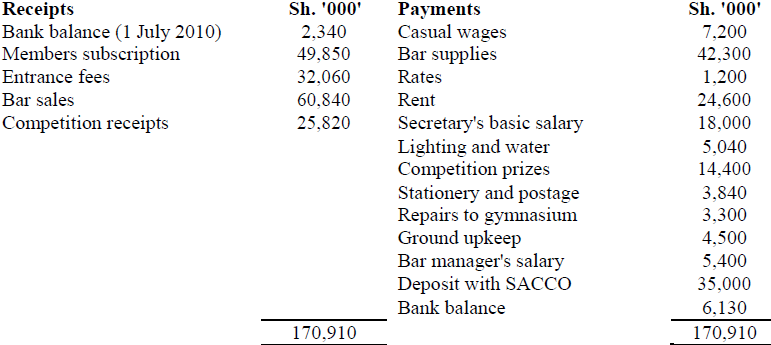 Additional information:
1. The assets of the club on 1 July 2010 were as follows:
Sh. '000'
Land 650,000
Gymnasium and equipment 250,000
Bar inventory 10,800
Prizes in hand 4,800
2. Bar supplies owing amounted to Sh. 4,200,000 on 1 July 2010
3. On 30 June 2011 the bar inventory was Sh. 9,600,000, prizes in hand - Sh. 2,400,00 and
Sh. 5,640,000 was owing for bar supplies.
4. The secretary is to receive a leave allowance of 5% of his basic salary. It was also agreed that
the bar manager should receive aSh. 500,000 bonus for increased sales during the year.
5. From the register of members, it appeared that unpaid subscriptions as at 30 June 2011
totaled Sh. 5,100,000. Subscriptions received during the year included Sh. 2,550,000 in
respect of the previous year and Sh. 1,700,000 in respect of the year starting 1 July 2011.
6. Interest earned on the deposit with the SACCO for the year ended 30 June 2011 amounted to Sh.
1,750,000
7. The rent paid was for fifteen months up to 30th September 2011
8. The gymnasium and equipment are to be depreciated at the rate of 10% per annum on straight
line basis
Required;-
a) Income and expenditure account for the year ended 30 June 2011
b) Statement of financial position as at 30 June 2011
Additional information:
1. The assets of the club on 1 July 2010 were as follows:
Sh. '000'
Land 650,000
Gymnasium and equipment 250,000
Bar inventory 10,800
Prizes in hand 4,800
2. Bar supplies owing amounted to Sh. 4,200,000 on 1 July 2010
3. On 30 June 2011 the bar inventory was Sh. 9,600,000, prizes in hand - Sh. 2,400,00 and
Sh. 5,640,000 was owing for bar supplies.
4. The secretary is to receive a leave allowance of 5% of his basic salary. It was also agreed that
the bar manager should receive aSh. 500,000 bonus for increased sales during the year.
5. From the register of members, it appeared that unpaid subscriptions as at 30 June 2011
totaled Sh. 5,100,000. Subscriptions received during the year included Sh. 2,550,000 in
respect of the previous year and Sh. 1,700,000 in respect of the year starting 1 July 2011.
6. Interest earned on the deposit with the SACCO for the year ended 30 June 2011 amounted to Sh.
1,750,000
7. The rent paid was for fifteen months up to 30th September 2011
8. The gymnasium and equipment are to be depreciated at the rate of 10% per annum on straight
line basis
Required;-
a) Income and expenditure account for the year ended 30 June 2011
b) Statement of financial position as at 30 June 2011
Date posted: May 16, 2019.
- Differentiate between "receipts and payments account" and "income and expenditure account".(Solved)
Differentiate between "receipts and payments account" and "income and expenditure account".
Date posted: May 16, 2019.
- Explain three reasons why in many organisations the cash flow for a given period differs from the
profit realised by the organisation in the same period.(Solved)
Explain three reasons why in many organisations the cash flow for a given period differs from the
profit realised by the organisation in the same period.
Date posted: May 16, 2019.
- Discuss three categories of financial ratios(Solved)
Discuss three categories of financial ratios
Date posted: May 16, 2019.
- Summarise three limitations of ratio analysis.(Solved)
Summarise three limitations of ratio analysis.
Date posted: May 16, 2019.
- Highlight six purposes of public sector accounting.(Solved)
Highlight six purposes of public sector accounting.
Date posted: May 16, 2019.
- The following were the approved estimates and actual expenditure for the Ministry of health for
the financial year ended 30 June 2013:
Drawings from the Exchequer during...(Solved)
The following were the approved estimates and actual expenditure for the Ministry of health for
the financial year ended 30 June 2013:
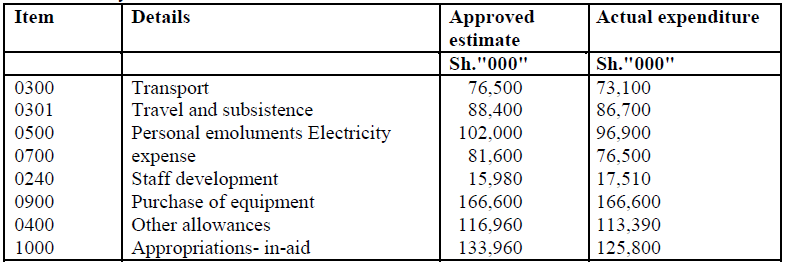 Drawings from the Exchequer during the financial year ended 30 June 2013 amounted to
Sh.127, 500,000.
Required:
(i) General account of vote.
(ii) Exchequer account.
(iii) Paymaster general account.
Drawings from the Exchequer during the financial year ended 30 June 2013 amounted to
Sh.127, 500,000.
Required:
(i) General account of vote.
(ii) Exchequer account.
(iii) Paymaster general account.
Date posted: May 16, 2019.
- Uzuri County Council authorised the construction of a city hall on 1 July 2012. The hall was
expected to cost Sh. 160,000,000. The project was to...(Solved)
Uzuri County Council authorised the construction of a city hall on 1 July 2012. The hall was
expected to cost Sh. 160,000,000. The project was to be financed as follows:
Sh. 80,000,000 from a 6.5% bond issue.
Sh. 64,000,000 from a government grant.
Sh. l6,000,000 from the general fund.
The following transactions and events took place during the year ended 30 June 2013:
1. The county council transferred Sh. 16,000,000 from the general fund to the city hall capital
fund. The capital project fund was for the purpose of construction of the city hall.
2. Planning and architects fees amounting to Sh.6,400,000 were paid.
3. The contract was awarded for Sh. 152, 000,000.
4. The 6.5% bonds were sold for Sh. 80,320,000 and the amount of the premium transferred to
the debt service fund.
5. The contract was certified 50% complete and an invoice for Sh.76,000,000 was received from
the contractor.
The contractor was paid the invoiced amount less 10% retention
Required:
i) Journal entries to record the above transactions.
ii) Statement of revenue and expenditure of the capital project fund for the year ended 30 June
2013.
iii) Statement of financial position of the capital project fund as at 30 June 2013.
Date posted: May 16, 2019.
- The following were the estimates and actual expenditure of Barani Ministry of Youth and Sports for
the financial year ended 30 June 2012.
Drawings from the exchequer...(Solved)
The following were the estimates and actual expenditure of Barani Ministry of Youth and Sports for
the financial year ended 30 June 2012.
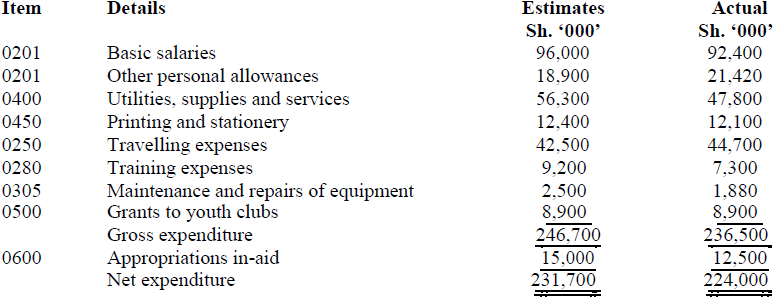 Drawings from the exchequer during the financial year ended 30 June 2012 amounted to
Sh.226,000,000
Required;
a) General account of vote
b) Exchequer account
c) Paymaster general (PMG) account
d) Appropriation account for the year ended 30 June 2012
e) Statement of assets and liabilities as at 30 June 2012
Drawings from the exchequer during the financial year ended 30 June 2012 amounted to
Sh.226,000,000
Required;
a) General account of vote
b) Exchequer account
c) Paymaster general (PMG) account
d) Appropriation account for the year ended 30 June 2012
e) Statement of assets and liabilities as at 30 June 2012
Date posted: May 16, 2019.
- The following details relate to the approved estimates and actual expenditure of a certain
government ministry for the financial year ended June 2012.
Required;-
Appropriation account for the...(Solved)
The following details relate to the approved estimates and actual expenditure of a certain
government ministry for the financial year ended June 2012.
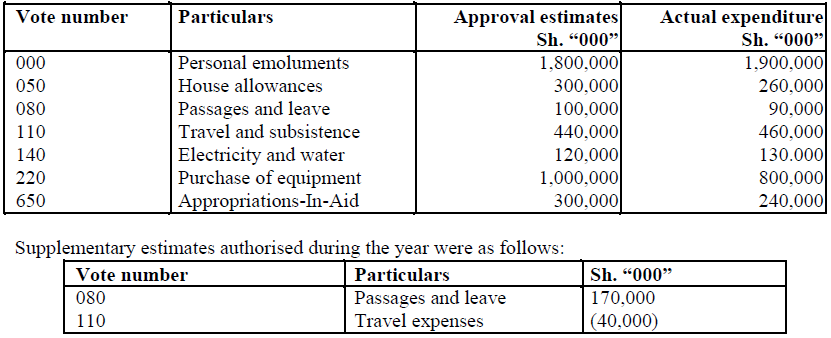 Required;-
Appropriation account for the year ended 30 June 2012.
Required;-
Appropriation account for the year ended 30 June 2012.
Date posted: May 16, 2019.
- Explain the following terms in the context of public sector accounting:
i) Commitment accounting
ii) Fund accounting(Solved)
Explain the following terms in the context of public sector accounting:
i) Commitment accounting
ii) Fund accounting
Date posted: May 16, 2019.
- Explain three roles of the International Public Sector Accounting Standards Board (IPSASB).(Solved)
Explain three roles of the International Public Sector Accounting Standards Board (IPSASB).
Date posted: May 16, 2019.
- Explain the meaning of the following terms in relation to Public Sector Accounting:
i) Appropriation-In-Aid
ii) Paymaster general
iii) General Account of Vote
iv) Exchequer Account(Solved)
Explain the meaning of the following terms in relation to Public Sector Accounting:
i) Appropriation-In-Aid
ii) Paymaster general
iii) General Account of Vote
iv) Exchequer Account
Date posted: May 16, 2019.
- The Ministry of Finance estimated the revenue from licences for the year ended 30 June 2010 to be
follows:
During the year, the treasury introduced a new...(Solved)
The Ministry of Finance estimated the revenue from licences for the year ended 30 June 2010 to be
follows:
 During the year, the treasury introduced a new vote head 018, second hand clothes licences
under supplement estimate number 1.The estimated revenue from this vote head was Sh450
million. The actual revenue during the year was as follows:
During the year, the treasury introduced a new vote head 018, second hand clothes licences
under supplement estimate number 1.The estimated revenue from this vote head was Sh450
million. The actual revenue during the year was as follows:
 Additional information:
1. The balance of revenue from licences as at 1 July 2009 was Sh. 325 million.
2. As at 30 June 2010, the amount of revenue from licences due to the Exchequer was Sh124 million
Required:
Statement of revenue for the year ended 30 June 2010.
Additional information:
1. The balance of revenue from licences as at 1 July 2009 was Sh. 325 million.
2. As at 30 June 2010, the amount of revenue from licences due to the Exchequer was Sh124 million
Required:
Statement of revenue for the year ended 30 June 2010.
Date posted: May 16, 2019.
- Highlight the importance of using accounting standards as the basis for preparing financial
statements.(Solved)
Highlight the importance of using accounting standards as the basis for preparing financial
statements.
Date posted: May 16, 2019.
- The International Public Sector Accounting Standards (IPSASs) recommend the use of accrual
basis of accounting for public sector entities.
Discuss the case for and against the use...(Solved)
The International Public Sector Accounting Standards (IPSASs) recommend the use of accrual
basis of accounting for public sector entities.
Discuss the case for and against the use of accrual basis of accounting in the public sector.
Date posted: May 16, 2019.
- Government expenditure is classified into recurrent expenditure and development
expenditure. Citing two examples, explain the two categories of expenditure.(Solved)
Government expenditure is classified into recurrent expenditure and development
expenditure. Citing two examples, explain the two categories of expenditure.
Date posted: May 16, 2019.
- Sunny Side Ltd. began its operations on 1 July 2012 by raising Sh.52 million ordinary share
capital and issuing 18% per annum debentures.
The following information was...(Solved)
Sunny Side Ltd. began its operations on 1 July 2012 by raising Sh.52 million ordinary share
capital and issuing 18% per annum debentures.
The following information was extracted from the books of the company for the year ended 30
June 2013:
1.
Item Sh. ‘000’
Dividends paid 3,376
Cash and bank balance 2,500
Operating costs (excluding finance cost) 31,320
Total non-current assets at net book value 60,000
2. The total current assets as at 30 June 2013 consisted
of: Σ Trade receivables.
Σ Inventory.
Σ Cash and bank balance.
3. The total current liabilities as at 30 June 2013 consisted of:
Σ Trade payables.
Σ Taxation charge for the year.
4. Taxation is to be provided for at the rate of 30% per annum.
5. 20% of the total sales for the year were made in cash.
6. Credit purchases during the year amounted to Sh. 28,800,000.
7. The accountant provided the following ratios which were determined from the financial
statements of the company:
Σ Inventory turnover 4.4 times
Σ Non-current asset turnover 1.8 times
Σ Gross profit margin 45%
Σ Average debt collection period 84 days
Σ Interest cover 4 times
Σ Average credit repayment period 90 days
Required:
i) Income statement for the year ended 30 June 2013.
ii) Statement of financial position as at 30 June 2013.
Note: Assume a year has 360 days.
Date posted: May 16, 2019.
- Explain the following terms as used in company accounts.
i) Cumulative preference shares.
ii) Public offer.
iii) Mortgaged debenture(Solved)
Explain the following terms as used in company accounts.
i) Cumulative preference shares.
ii) Public offer.
iii) Mortgaged debenture
Date posted: May 16, 2019.
- Meja and Kariuki have been trading as partners sharing profits and losses in the ratio of their fixed
capitals. The statement of financial position of the...(Solved)
Meja and Kariuki have been trading as partners sharing profits and losses in the ratio of their fixed
capitals. The statement of financial position of the partnership as at 31 March 2011 was as follows:
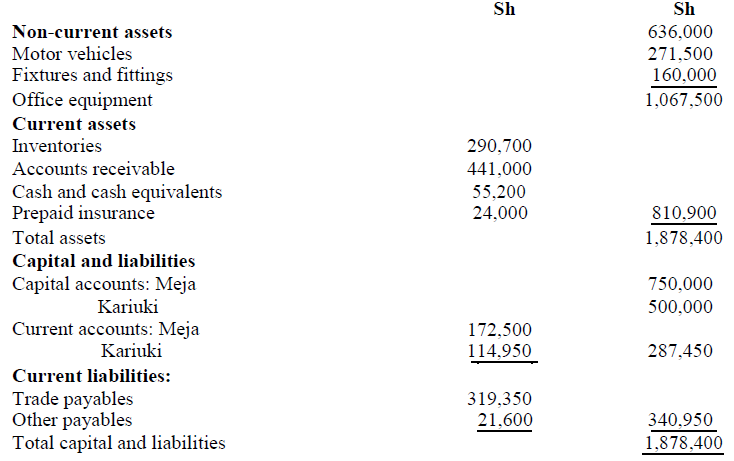 The partners have been having some disagreements on the following issues:
1. The historical cost of the assets did not reflect the fair value of the assets.
2. Although the partners contributed different amounts as fixed capital, the partnership agreement
did not provide for payment of interest on capital.
3. Kariuki devoted his entire working time to the business of the partnership but the partnership
agreement did not provide for any salaries for active partners.
4. Kariuki strongly believed that the present profits and losses sharing ratio was inequitable.
At a meeting convened to resolve the above issues, the partners agreed as follows:
i) The non-current assets as at 31 March 2011 were to be revalued as follows:
Sh.
Motor vehicles 600,000
Fixtures and fittings 262,500
Office equipment 225,000
ii) Inventories as at 31 March 2011 were to be written down to Sh. 275,000 and Sh 16,000 was
to be written off as bad debts. An allowance for doubtful debts of 5% was to be provided on
the remaining accounts receivable.
iii) Interest on capital was to be allowed at 5% per annum for the years ended 31 March 2010 and
31 March 2011.
iv) Kariuki was to be paid a salary of Sh 90,000 per annum for the years ended 31 March 2010
and 31 March 2011.
v) Profits and losses were to be shared equally with effect from 1 April 2009
vi) Meja was to be compensated for his loss arising from the new profit sharing agreement by
allowing him goodwill of Sh. 200,000.The goodwill would not be retained in the books of the
partnership. The net profits for the year ended 31 March 2009,2010 and 2011 were Sh.
425,000,Sh. 525000 and Sh. 412,500 respectively.
Required:
a) Adjusted income statement and appropriation 2011 account for the years ended 31 March 2010
and 31March 2011
b) Partners' current accounts.
c) Statement of financial position as at 31 March 2011.
The partners have been having some disagreements on the following issues:
1. The historical cost of the assets did not reflect the fair value of the assets.
2. Although the partners contributed different amounts as fixed capital, the partnership agreement
did not provide for payment of interest on capital.
3. Kariuki devoted his entire working time to the business of the partnership but the partnership
agreement did not provide for any salaries for active partners.
4. Kariuki strongly believed that the present profits and losses sharing ratio was inequitable.
At a meeting convened to resolve the above issues, the partners agreed as follows:
i) The non-current assets as at 31 March 2011 were to be revalued as follows:
Sh.
Motor vehicles 600,000
Fixtures and fittings 262,500
Office equipment 225,000
ii) Inventories as at 31 March 2011 were to be written down to Sh. 275,000 and Sh 16,000 was
to be written off as bad debts. An allowance for doubtful debts of 5% was to be provided on
the remaining accounts receivable.
iii) Interest on capital was to be allowed at 5% per annum for the years ended 31 March 2010 and
31 March 2011.
iv) Kariuki was to be paid a salary of Sh 90,000 per annum for the years ended 31 March 2010
and 31 March 2011.
v) Profits and losses were to be shared equally with effect from 1 April 2009
vi) Meja was to be compensated for his loss arising from the new profit sharing agreement by
allowing him goodwill of Sh. 200,000.The goodwill would not be retained in the books of the
partnership. The net profits for the year ended 31 March 2009,2010 and 2011 were Sh.
425,000,Sh. 525000 and Sh. 412,500 respectively.
Required:
a) Adjusted income statement and appropriation 2011 account for the years ended 31 March 2010
and 31March 2011
b) Partners' current accounts.
c) Statement of financial position as at 31 March 2011.
Date posted: May 16, 2019.
- John and Joel were partners in a business sharing profits and losses in the ratio of 2:1. Interest on
fixed capital was allowed at the rate...(Solved)
John and Joel were partners in a business sharing profits and losses in the ratio of 2:1. Interest on
fixed capital was allowed at the rate of 10% per annum. No interest was charged on current accounts.
On 30 September 2011 Joy was admitted as a partner and from that date profits and losses were to be
shared in the ratio of 2:2:1 for John, Joel and Joy respectively. Goodwill was not to be retained in the
books with adjusting entries being made in the current accounts.
The following trial balance was extracted from the partnership's books of account as at 31 March
2012:
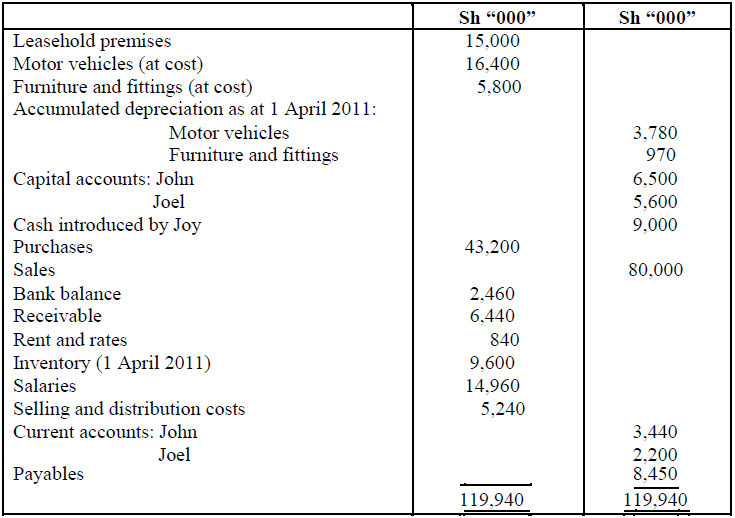 Additional information:
1. No entries have been made to record the admission of Joy. Goodwill was agreed at Sh.10.5
million. Sh.6 million of the cash introduced by Joy was the fixed capital.
2. Salaries include the following partners' drawings:
Sh ‘000’
John 2,580
Joel 2,040
Joy 680
3. Depreciation is to be provided as follows:
Asset Rate per annum
Motor vehicles 20% on cost
Furniture and fittings 10% on cost
4. The sales during the six month period from 1 October 2011 to 31 March 2012 were 50% more
than the sales during the six month period from 1 April 2011 to 30 September 2011. The selling
and distribution expenses varied with the sales.
All other expenses accrued evenly.
5. Inventory as at 31 March 2012 was valued at Sh.11 million.
6. Allowance for doubtful debts was Sh.229,000 as at 30 September 2011 and Sh.309,000 as at 31
March 2012.
7. The leasehold premises is to be amortised over 30 years from 31 March 2011
Required:
a) Income statement for the year ended 31 March 2012.
b) Statement of financial position as at 3 I March 2012.
c) Partners' current accounts.
Additional information:
1. No entries have been made to record the admission of Joy. Goodwill was agreed at Sh.10.5
million. Sh.6 million of the cash introduced by Joy was the fixed capital.
2. Salaries include the following partners' drawings:
Sh ‘000’
John 2,580
Joel 2,040
Joy 680
3. Depreciation is to be provided as follows:
Asset Rate per annum
Motor vehicles 20% on cost
Furniture and fittings 10% on cost
4. The sales during the six month period from 1 October 2011 to 31 March 2012 were 50% more
than the sales during the six month period from 1 April 2011 to 30 September 2011. The selling
and distribution expenses varied with the sales.
All other expenses accrued evenly.
5. Inventory as at 31 March 2012 was valued at Sh.11 million.
6. Allowance for doubtful debts was Sh.229,000 as at 30 September 2011 and Sh.309,000 as at 31
March 2012.
7. The leasehold premises is to be amortised over 30 years from 31 March 2011
Required:
a) Income statement for the year ended 31 March 2012.
b) Statement of financial position as at 3 I March 2012.
c) Partners' current accounts.
Date posted: May 16, 2019.
- Kanini, Lucy and Ndwiga are in partnership sharing profits and losses in the ratio 3:2:1 respectively. Ndwiga decided to retire on 31 December 2012 and Gitonga...(Solved)
Kanini, Lucy and Ndwiga are in partnership sharing profits and losses in the ratio 3:2:1 respectively.
Ndwiga decided to retire on 31 December 2012 and Gitonga was admitted as a partner on that date.
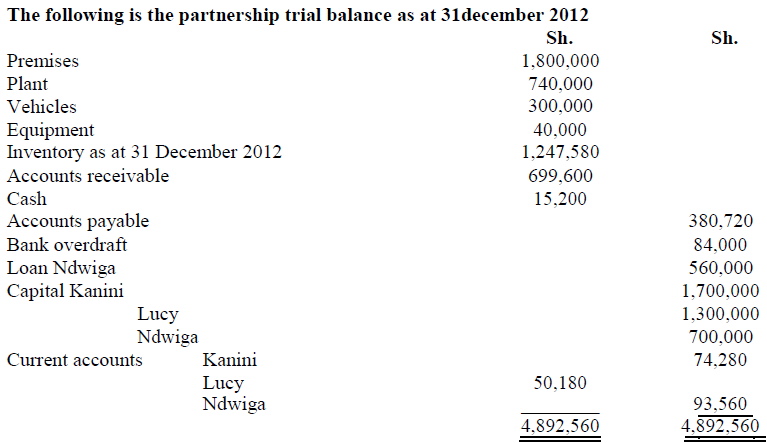 Additional information
1. Revaluation premises Sh. 2,400,000 plant Sh. 700,000 and inventory Sh. 1,083,580
2. Allowance for doubtful debts amounting to sh. 60,000 is to be provided
3. Goodwill amounting to sh. 840,000 is to be recorded in the books on the day Ndwiga retires. The
partners in the new partnership do not wish to maintain goodwill.
4. Kanini and Lucy are to share profits in the same ratio as before. Gitonga will have the same
share of profits as Lucy.
5. Ndwiga is to take his car at book value of sh. 78,000 in part payment and the balance of all he is
owned by the firm in cash except sh. 400,000 which he is willing to leave as a loan account.
6. The partners in the new firm are to start on equal footing so far as capital and current accounts are
concerned. Gitonga is to contribute cash to bring his capital and current accounts to the same
amount as the original partner from the old firm who has the lower investment in the business
7. The original partner in the old firm who has the higher investment will draw cash so that capital
and current account balances equal those of his new partners
Required;-
a) Partners capital account
b) Partners current account
c) Statement of financial position for the partnership of Kanini, Lucy and Gitonga as at 31
December 2012
Additional information
1. Revaluation premises Sh. 2,400,000 plant Sh. 700,000 and inventory Sh. 1,083,580
2. Allowance for doubtful debts amounting to sh. 60,000 is to be provided
3. Goodwill amounting to sh. 840,000 is to be recorded in the books on the day Ndwiga retires. The
partners in the new partnership do not wish to maintain goodwill.
4. Kanini and Lucy are to share profits in the same ratio as before. Gitonga will have the same
share of profits as Lucy.
5. Ndwiga is to take his car at book value of sh. 78,000 in part payment and the balance of all he is
owned by the firm in cash except sh. 400,000 which he is willing to leave as a loan account.
6. The partners in the new firm are to start on equal footing so far as capital and current accounts are
concerned. Gitonga is to contribute cash to bring his capital and current accounts to the same
amount as the original partner from the old firm who has the lower investment in the business
7. The original partner in the old firm who has the higher investment will draw cash so that capital
and current account balances equal those of his new partners
Required;-
a) Partners capital account
b) Partners current account
c) Statement of financial position for the partnership of Kanini, Lucy and Gitonga as at 31
December 2012
Date posted: May 16, 2019.
- Sylivia and William are in a partnership business trading under the name Slywill Enterprises. Their
statement of financial position as at 31 October 2013 failed to...(Solved)
Sylivia and William are in a partnership business trading under the name Slywill Enterprises. Their
statement of financial position as at 31 October 2013 failed to agree. The difference was-posted to a
suspense account pending investigations as shown below:
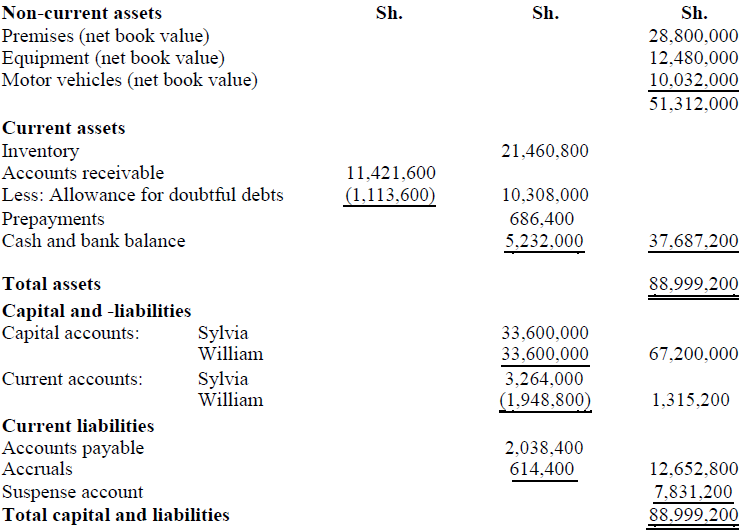 Additional information:
After checking all the entries, the following errors were discovered:
1. Discounts received of Sh. 633,600 had been debited to discounts allowed account.
2. The sales account had been undercast by Sh. 4,800,000.
3. The purchase returns day book had been correctly entered and totalled at Sh. 2,956,800 but had
not been posted to the ledger.
4. A credit sale of Sh. 705,600 had been debited to the customer's account as Sh. l,029,600.
5. A motor vehicle originally bought for Sh.3,360,000 four years ago and depreciated at 20% using
the straight-line method had a residual value of Sh.480,000. The motor vehicle was disposed of at
Sh.1,440,000
No entries, other than bank account, had been passed through the books.
6. An accrual of Sh. 268,800 for electricity charges had been omitted from the books.
7. A bad debt of Sh. 748,800 had not been written off.
8. Allowance for doubtful debts should be maintained at 10% of accounts receivable.
9. Sylvia's current account had been credited with a partnership salary of Sh. 1,440,000 which
should have been credited to William’s current account.
10. Sylvia had withdrawn goods worth Sh.940,800 for personal use. No entry had been made in the
partnership books.
11. The partners share profits as follows:
Sylvia - 60%
William - 40%
Required:
a) Suspense account, duly balanced, for the year ended 31 October 2013
b) Statement of adjustments to show the correct net profit for the year ended 31 October 2013
c) Partners' current accounts.
d) Statement of financial position as at 31 October 2013.
Additional information:
After checking all the entries, the following errors were discovered:
1. Discounts received of Sh. 633,600 had been debited to discounts allowed account.
2. The sales account had been undercast by Sh. 4,800,000.
3. The purchase returns day book had been correctly entered and totalled at Sh. 2,956,800 but had
not been posted to the ledger.
4. A credit sale of Sh. 705,600 had been debited to the customer's account as Sh. l,029,600.
5. A motor vehicle originally bought for Sh.3,360,000 four years ago and depreciated at 20% using
the straight-line method had a residual value of Sh.480,000. The motor vehicle was disposed of at
Sh.1,440,000
No entries, other than bank account, had been passed through the books.
6. An accrual of Sh. 268,800 for electricity charges had been omitted from the books.
7. A bad debt of Sh. 748,800 had not been written off.
8. Allowance for doubtful debts should be maintained at 10% of accounts receivable.
9. Sylvia's current account had been credited with a partnership salary of Sh. 1,440,000 which
should have been credited to William’s current account.
10. Sylvia had withdrawn goods worth Sh.940,800 for personal use. No entry had been made in the
partnership books.
11. The partners share profits as follows:
Sylvia - 60%
William - 40%
Required:
a) Suspense account, duly balanced, for the year ended 31 October 2013
b) Statement of adjustments to show the correct net profit for the year ended 31 October 2013
c) Partners' current accounts.
d) Statement of financial position as at 31 October 2013.
Date posted: May 16, 2019.
- The following balances were extracted from the boob of Chuma Enterprises as at 30 September 2003.
Additional information:
1. Provision for depreciation on the motor vehicle and...(Solved)
The following balances were extracted from the boob of Chuma Enterprises as at 30 September 2003.
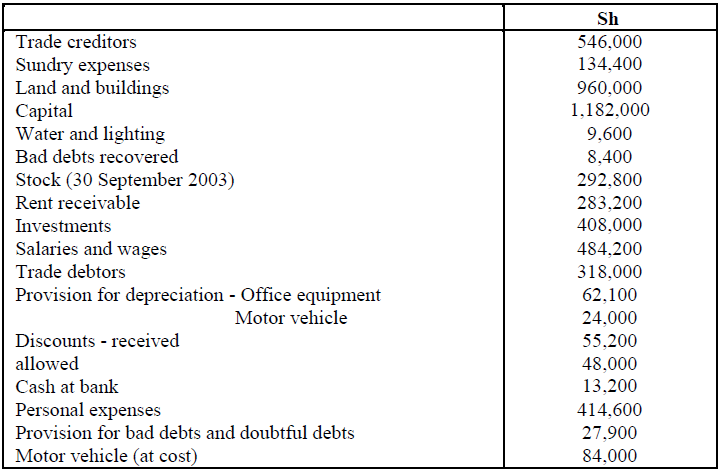
 Additional information:
1. Provision for depreciation on the motor vehicle and office equipment is to be provided so as to
reflect two years depreciation at the rate of 20% per annum on cost.
2. Rent received amounting to Sh.6,000 has not been recorded ill the accounts. The
proprietor converted this money to personal use.
3. The sales day book had been overcast by Sh.9,000.
4. Discounts allowed amounting to Sh.7,200 had been posted to the discounts allowed account but
not to the debtors account.
5. The sales returns day book had been overcast by Sh1,800.
6. Stock at 30 September 2003 included an item valued at Sh.60,000 which had been sold and
invoiced to a customer on 30 September 2003.
Required:
a) Profit and loss account for the year ended 30 September 2003
b) Balance sheet as a. 30 September 2003
Additional information:
1. Provision for depreciation on the motor vehicle and office equipment is to be provided so as to
reflect two years depreciation at the rate of 20% per annum on cost.
2. Rent received amounting to Sh.6,000 has not been recorded ill the accounts. The
proprietor converted this money to personal use.
3. The sales day book had been overcast by Sh.9,000.
4. Discounts allowed amounting to Sh.7,200 had been posted to the discounts allowed account but
not to the debtors account.
5. The sales returns day book had been overcast by Sh1,800.
6. Stock at 30 September 2003 included an item valued at Sh.60,000 which had been sold and
invoiced to a customer on 30 September 2003.
Required:
a) Profit and loss account for the year ended 30 September 2003
b) Balance sheet as a. 30 September 2003
Date posted: May 16, 2019.